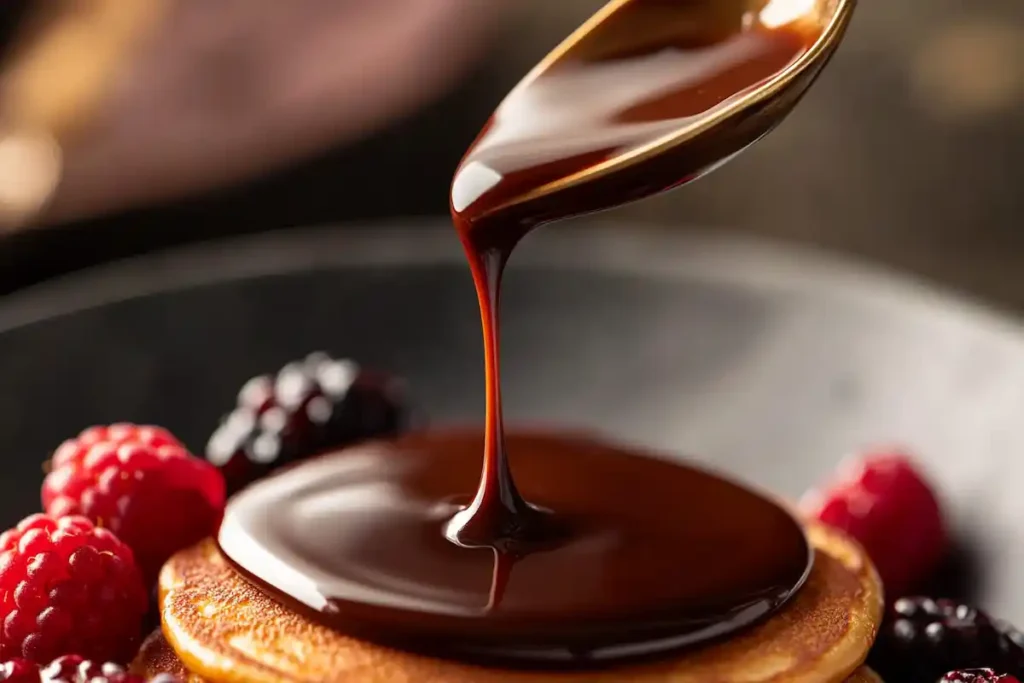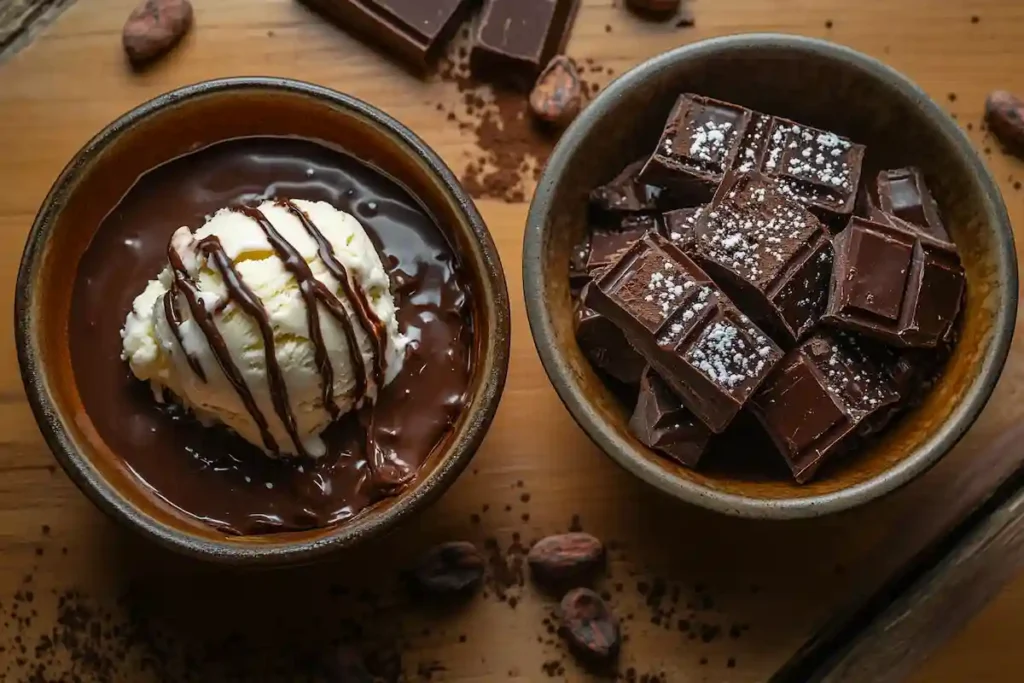Introduction
Discover what’s the difference between chocolate sauce and chocolate fudge, their uses, and how to make them.
Chocolate is one of the most beloved treats in the United States, and it comes in countless forms. What’s the difference between chocolate sauce and chocolate fudge? Many dessert lovers often wonder how these two chocolatey delights differ. Both are sweet, indulgent, and full of rich cocoa flavor. However, they fulfill different culinary purposes, have distinct textures, and require different techniques to create. Throughout this detailed article, we will explore each aspect of these chocolate treats. We will examine their ingredients, preparation methods, flavor profiles, and ideal uses. Eventually, you will gain a clear sense of how chocolate sauce and chocolate fudge differ, and how to choose the perfect one for your next dessert project.
1. What’s the difference between chocolate sauce and chocolate fudge? The Basics Explained

Understanding what’s the difference between chocolate sauce and chocolate fudge? begins with their core characteristics. Chocolate sauce is generally a thin, pourable mixture, crafted from cocoa powder or chocolate, sugar, cream or milk, and butter. It flows smoothly and can easily coat desserts. Chocolate fudge, conversely, results in a dense, chewy candy-like product. It forms from a sugar syrup cooked to a certain stage, combined with chocolate and butter, then cooled and beaten until it sets into a solid mass.
Chocolate Sauce Basics:
- Generally made with cocoa powder or melted chocolate, sugar, and liquid dairy.
- Easily pourable and fluid at room temperature.
- Used primarily as a topping or ingredient to enhance desserts.
Chocolate Fudge Basics:
- Made by cooking sugar, butter, and cream (or condensed milk) with chocolate.
- Firms up into dense, chewy blocks or pieces.
- Often consumed as candy or used as a filling layer.
Because chocolate sauce is simpler and more fluid, it is versatile and easy to integrate into many desserts. Fudge, meanwhile, is less of a topping and more of a standalone treat. Indeed, fudge can also be an ingredient in baked goods, adding richness and body.
2. What’s the difference between chocolate sauce and chocolate fudge? Key Flavor Differences
When exploring what’s the difference between chocolate sauce and chocolate fudge? focusing on flavor offers more insights. Both items boast chocolatey goodness, but they differ in intensity and sweetness. Chocolate sauce usually features a balanced, sweet cocoa flavor that complements other desserts. It often has a gentle chocolate intensity, especially if made with cocoa powder. Its sweetness can vary, but it rarely overwhelms the dish. Instead, it aims to amplify or enhance.
Conversely, chocolate fudge packs a richer, bolder punch. Because of the sugar syrup cooking stage, fudge’s sweetness intensifies. The chocolate flavor is robust and concentrated, yielding a melt-in-your-mouth texture. Fudge, especially when made from high-quality chocolate, delivers a profound cocoa hit that can stand on its own. While chocolate sauce supports other flavors, fudge demands attention and can serve as a dessert centerpiece.
3. What’s the difference between chocolate sauce and chocolate fudge?Common Culinary Uses
Examining what’s the difference between chocolate sauce and chocolate fudge? also involves understanding their respective culinary roles. Chocolate sauce shines as a garnish or ingredient. It drizzles beautifully over ice cream sundaes, pancakes, waffles, crepes, and cheesecake. It blends seamlessly into milkshakes and mochas. Its fluid consistency makes it a go-to for adding a chocolatey accent. Another crucial advantage is its ability to be customized. You can adjust sweetness, thickness, and flavor intensity depending on the dish.
On the other hand, fudge often appears as a confection in its own right. Sold in cubes or bars, fudge is a sweet treat that people enjoy as candy. Additionally, fudge can act as a decadent layer within brownies, cakes, or cookie bars. Because it sets firmly, it can also be cut into shapes or rolled into balls. Its firmness and thick density contrast with the pourable nature of sauce. Consequently, fudge often steals the show as a featured element rather than playing a supporting role.
What’s the difference between chocolate sauce and chocolate fudge? Texture and Consistency
Digging deeper into what’s the difference between chocolate sauce and chocolate fudge? we find that texture plays a central role. Chocolate sauce is fluid and glossy. It slips easily off a spoon and flows smoothly over desserts. Its consistency resembles that of a thick syrup or caramel sauce. Because of this, it can integrate into a variety of recipes without overpowering them.
Fudge, on the contrary, is all about density. Its texture is creamy yet firm. When you bite into good fudge, it offers a slight resistance before yielding into a smooth, rich chew. Unlike sauce, which you pour, fudge stands independently. This textural difference is largely due to sugar crystallization. As fudge cooks and cools, sugar crystals form in a controlled manner, creating that signature fudgy consistency. This crystallization process sets fudge apart from sauce, which remains liquid and does not crystallize in the same way.
What’s the difference between chocolate sauce and chocolate fudge? Serving Suggestions
When considering what’s the difference between chocolate sauce and chocolate fudge? it helps to think about serving suggestions. Chocolate sauce pairs well with cold desserts, such as ice cream and frozen yogurt. Drizzle it over a parfait or swirl it into whipped cream. It also enhances warm desserts. Pour it over bread pudding or molten chocolate cake for a dramatic chocolate finish. In beverages, chocolate sauce can create hot chocolate or mochas.
Fudge, in contrast, is best enjoyed as a standalone sweet or integrated into pastries. You might slice fudge into bite-sized pieces and serve on a platter. Alternatively, chop fudge and fold it into brownies or cookie dough. You could even place fudge pieces between cake layers for extra richness. Essentially, fudge offers a concentrated burst of sweetness and chocolate flavor, making it ideal for candy lovers.
What’s the difference between chocolate sauce and chocolate fudge? Storage and Shelf Life

Storage and shelf life also reveal what’s the difference between chocolate sauce and chocolate fudge? Fresh chocolate sauce often contains dairy and needs refrigeration to maintain quality. It will last a week or two when kept chilled. Some sauces, made without dairy, can remain stable at room temperature. However, they still may degrade over time, losing flavor or developing graininess.
Fudge, however, typically contains enough sugar to act as a natural preservative. Wrapped carefully and stored in a cool, dry place, fudge can keep for several weeks. It’s more shelf-stable than sauce and does not necessarily require refrigeration. In fact, chilling fudge might change its texture. By understanding these differences, you can better plan for storing homemade or store-bought chocolate treats.
Understanding Chocolate Sauce in Depth
Chocolate sauce usually begins with cocoa powder, sugar, a dairy product (like cream), and butter. Occasionally, chefs add corn syrup or invert sugar to maintain a smooth texture. Because chocolate sauce remains liquid, it adapts well to many flavorings. Add peppermint extract, coffee, or a pinch of cayenne pepper for a twist. Similarly, you can adjust its thickness by altering the ratio of liquid to chocolate.
When making chocolate sauce at home, you can melt chocolate with cream and sugar over low heat. Stir until smooth and glossy. If you prefer a cocoa-based sauce, whisk cocoa powder, sugar, and water or cream until dissolved. Afterward, simmer gently until it thickens. Once cooled slightly, your sauce is ready to drizzle. The key is not to overcook it. Overheating can lead to a burnt or bitter taste.
Chocolate sauce also adapts to dietary needs. For instance, use dairy-free milk and vegan butter for a plant-based version. Swap sugar for a zero-calorie sweetener to reduce sugar content. Because it’s a sauce, you have more flexibility to fine-tune flavor and consistency to suit personal preferences.
Understanding Chocolate Fudge in Depth
Chocolate fudge requires more precision. Basically, fudge involves cooking sugar, butter, and cream (or condensed milk) until the sugar dissolves and the mixture reaches a certain temperature. Usually around the soft-ball stage (around 234°F to 240°F). Once removed from heat, you add chocolate and often vanilla extract. Letting it cool slightly before beating it ensures a smooth texture. Beating fudge introduces tiny sugar crystals that give fudge its creamy firmness.
This process demands attention. Overcooking can yield dry or crumbly fudge. Undercooking results in a fudge that never sets properly. Achieving the right sugar crystallization is key. The reward is a thick, sliceable candy with intense chocolate flavor.
Homemade fudge also allows for creativity. Add chopped nuts, dried fruit, or swirl in peanut butter. You can also experiment with dark, milk, or white chocolate. Vegan fudge recipes replace dairy with coconut milk or nut milks. Likewise, sugar substitutes can reduce calories, though achieving the perfect crystal structure might be trickier.
Historical Perspectives
Chocolate sauce traces roots to European cuisine, especially French recipes calling for chocolate syrups. It became a staple in American dessert culture in the early 20th century. Ice cream parlors popularized hot fudge sundaes, though their “hot fudge” topping often resembles a thick chocolate sauce rather than classic fudge candy. Over time, chocolate sauce diversified as chocolate became cheaper and more accessible.
Chocolate fudge emerged in the late 19th century in America. The origin stories vary, but many believe fudge was a happy accident. It gained popularity in the early 20th century and became a hallmark of confectionery shops. Resorts and candy stores sold fudge in tourist towns across the U.S. Eventually, fudge became synonymous with American candy culture, while chocolate sauce integrated into everyday desserts and beverages.
Homemade vs. Store-Bought
If you want ultimate control over flavor and texture, homemade chocolate sauce or fudge is ideal. You can choose your chocolate, sweetness level, and even experiment with spices. Making fudge at home, although more challenging, ensures top quality. You can avoid artificial flavors and corn syrups found in some store-bought options.
Store-bought chocolate sauce and fudge, on the other hand, offer convenience. They are shelf-stable and ready to use. Many brands produce high-quality products using premium chocolate. Others cater to dietary needs with sugar-free or vegan versions. When selecting store-bought fudge, opt for brands that list chocolate or cocoa butter as a primary ingredient. High-quality chocolate sauce should also feature cocoa or real chocolate upfront.
4. Health and Dietary Considerations
Chocolate sauce and chocolate fudge are indulgences. However, you can make choices to manage nutrition. Chocolate sauce tends to be lower in fat and calories per serving than fudge because it’s less dense. However, it still contains sugar and should be enjoyed in moderation. Using unsweetened cocoa powder and non-dairy milk can create a lighter sauce. Sugar substitutes can reduce calories.
Fudge, with its higher sugar and butter content, is more calorie-dense. Because it’s a concentrated candy, even a small piece contains significant sugar and fat. For health-conscious individuals, portion control is key. Alternatively, you could craft fudge using lower-glycemic sweeteners, though achieving the right texture may be challenging.
In both cases, remember that these treats are best enjoyed occasionally. Pair them with fresh fruit or whole-grain desserts to balance indulgence with nutrition.
Nutritional Comparison of Chocolate Sauce and Chocolate Fudge
Understanding the nutritional differences between chocolate sauce and chocolate fudge can help you make informed choices for your desserts. Here’s a breakdown of their approximate nutritional values per 100g serving:
Nutritional Content of Chocolate Sauce and Chocolate Fudge (Per 100g)
Below is a detailed comparison of the nutritional content of chocolate sauce and chocolate fudge:
| Nutrient | Chocolate Sauce (Per 100g) | Chocolate Fudge (Per 100g) |
|---|---|---|
| Calories | 200 | 450 |
| Total Fat | 10g | 18g |
| Saturated Fat | 6g | 11g |
| Carbohydrates | 28g | 60g |
| Sugar | 22g | 55g |
| Protein | 2g | 4g |
| Fiber | 2g | 1g |
| Sodium | 40mg | 30mg |
Key Takeaways:
- Calories: Chocolate fudge is significantly higher in calories than chocolate sauce due to its denser texture and concentrated ingredients.
- Fat: Fudge contains nearly double the total fat of chocolate sauce, including a higher level of saturated fats.
- Carbohydrates & Sugar: Fudge is sweeter, with almost twice the sugar content of chocolate sauce.
- Protein: Fudge provides a slightly higher protein level, though neither is a substantial source.
- Fiber & Sodium: Chocolate sauce offers slightly more fiber, while sodium levels are relatively low for both.
These nutritional insights can guide you in selecting the right option based on your dietary preferences and goals. For a lighter dessert topping, chocolate sauce is ideal. However, if you’re indulging in a standalone treat, fudge delivers a richer experience.
5. Cultural and Culinary Context
In the U.S., chocolate sauce and fudge hold special places in dessert culture. Chocolate sauce elevates simple treats like ice cream or pancakes. Meanwhile, fudge is associated with vacations at seaside towns where candy shops offer endless varieties. Each has a nostalgic charm. Tourists often bring home boxes of fudge as souvenirs.
Globally, variations exist. In Europe, chocolate sauces accompany crepes and pastries. In Latin America, thicker chocolate sauces appear in traditional sweets. While fudge is distinctly American, other cultures have similar confections. For example, in South Asia, some milk-based sweets share a fudge-like texture. The universal love of chocolate ensures that wherever you go, some form of rich chocolate treat awaits.
6. Tips for Perfect Homemade Chocolate Sauce and Chocolate Fudge
- Ingredient Quality:
Choose high-quality chocolate. For sauce, a good cocoa powder or real chocolate bar makes a difference. For fudge, the better the chocolate, the richer the flavor. - Temperature Control:
Chocolate sauce rarely needs a thermometer. Just heat gently and don’t scorch the chocolate. Fudge, however, requires precision. Use a candy thermometer to reach the soft-ball stage. - Stirring and Cooling:
Stir chocolate sauce until smooth and integrated. For fudge, proper beating after cooking ensures a creamy texture. Do not rush the cooling stage or you risk graininess. - Flavor Enhancements:
Add a pinch of salt to intensify chocolate flavor. Introduce spices, extracts, or even a tablespoon of espresso. For fudge, folding in nuts or toffee bits creates complexity.
By mastering these tips, you will better appreciate the nuances of each dessert. Experiment with both methods to discover new favorite recipes.
7. Frequently Asked Questions About Chocolate Sauce and Chocolate Fudge
What is the difference between chocolate sauce and fudge?
Chocolate sauce is a pourable topping made from chocolate, sugar, and dairy. It remains fluid and enhances desserts like ice cream. Fudge is a firm, chewy candy made by cooking sugar and chocolate to a specific temperature, resulting in a dense, sliceable confection.
Are chocolate sauce and chocolate syrup the same thing?
Chocolate sauce and chocolate syrup are similar, but syrup often refers to a lighter, more liquid form made with cocoa powder and sugar dissolved in water. Chocolate sauce may contain cream or butter for richness, while syrup is often simpler and thinner.
Is chocolate sauce the same as melted chocolate?
Chocolate sauce is not the same as just melted chocolate. Melted chocolate can re-harden once cooled. Chocolate sauce usually includes additional ingredients, like cream or butter, to keep it fluid and spoonable at room temperature.
What is the difference between chocolate and chocolate fudge?
Chocolate refers to the raw or processed cocoa-based product (bars, chips, etc.). Chocolate fudge is a confection made by cooking sugar, butter, and chocolate into a candy-like mass. Fudge has a distinct firm and creamy texture that pure chocolate does not.
Conclusion
In conclusion, what’s the difference between Chocolate Sauce and Chocolate Fudge? Understanding their differences lies in examining their ingredients, preparation methods, and culinary roles. Chocolate Sauce and Chocolate Fudge serve distinct purposes—while chocolate sauce flows smoothly as a topping, elevating desserts with its sweet, subtle cocoa notes, Chocolate Sauce and Chocolate Fudge offer different textures and flavors. Chocolate fudge, meanwhile, stands proud as a dense, rich candy, delivering a concentrated chocolate experience in every bite.
By learning their unique characteristics, you can choose the best option for your dessert. For a delicate drizzle over ice cream, opt for Chocolate Sauce and Chocolate Fudge, depending on whether you prefer a smooth or thick consistency. Both have their place, and both deserve a spot in the kitchen of any chocolate lover. Ultimately, appreciating these subtle differences can deepen your understanding of Chocolate Sauce and Chocolate Fudge and their delicious versatility.

